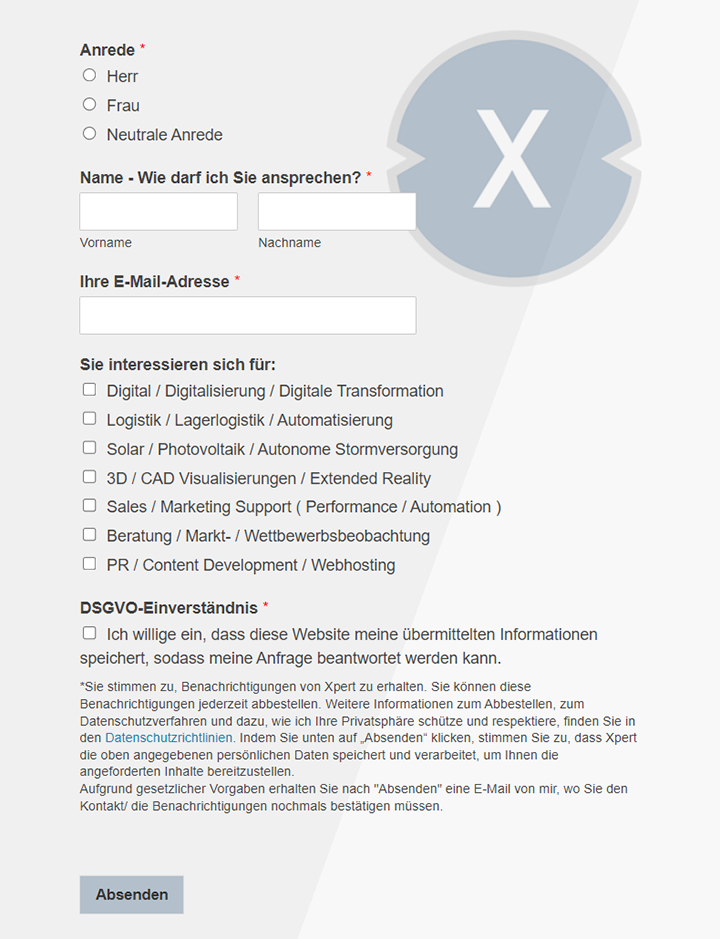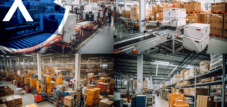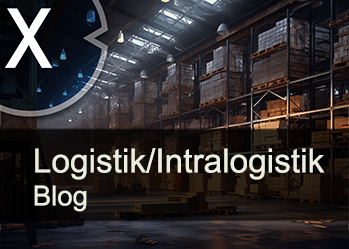Key technology: mobile phone masts for Industry 4.0: Sensor technology, autonomy and automation in modern warehouse management
Xpert pre-release
Language selection 📢
Published on: August 13, 2025 / Updated on: August 13, 2025 – Author: Konrad Wolfenstein

Key technology: Cell phone towers for Industry 4.0: Sensor technology, autonomy and automation in modern warehouse management – Image: Xpert.Digital
From the container to the smallest screw: This is how the fully automated warehouse of the future works with 5G and AI
What is a semi-permanent cell tower and why is it so important for industrial infrastructure?
A semi-permanent cell phone tower like the 4RGM4818_m from IAB Industrieanlagenbau GmbH represents a revolutionary solution for the expansion of digital infrastructure. This 48-meter-high tower can be used both mobile and permanently and does not require a poured foundation. This not only eliminates the complex permitting process, but also allows the tower to be put into operation during the permitting process. This flexible construction method makes it possible to erect a complete cell phone station in just over a week.
The significance lies in accelerating the digital infrastructure expansion, which is essential for modern Industry 4.0 applications. With a modular design consisting of eight six-meter sections and a maximum antenna coverage of 18 square meters on the top six meters, the mast meets all the technical requirements for modern 5G campus networks.
Suitable for:
- Smart Factory: Super -fast data networks for future scenarios of intralogistics – 5G technology & network – 5G SA campus network
How does the innovative mast construction differ from conventional cell phone masts?
The key difference lies in the revolutionary foundation technology. While conventional cell phone towers require a poured concrete foundation, the 4RGM4818_m uses precast concrete slabs with a permissible soil pressure of 200 kN/m². This so-called "flying construction" allows for easy dismantling and reuse of the tower.
The delicate tubular construction combines high stability with a transparent appearance and meets all requirements of DIN EN 1991-1-4 for wind zone II and terrain category II. This design offers operators a twofold advantage: on the one hand, it enables flexible site selection and short-term response in the event of grid bottlenecks, and on the other hand, it allows for rapid implementation even in sensitive locations such as major events or temporary grid outages.
What role does 5G technology play in modern warehouse logistics?
5G technology is revolutionizing warehouse logistics with its distinctive features: ultra-high speeds of up to 10 gigabits per second, latency of less than a millisecond, and the ability to connect multiple devices simultaneously. These features enable real-time communication between automated systems, which is crucial for automating warehouse processes.
In modern warehouse systems, 5G technology enables real-time inventory management, instant order processing, and immediate updates of stock and shipping status. Especially in automated small parts warehouses and high-bay pallet warehouses, 5G enables the seamless integration of sensor technology, autonomous mobile robots, and intelligent warehouse management systems.
How do automated small parts warehouses work in Industry 4.0?
Automated small parts warehouses (ASWs) are highly efficient, computer-controlled storage systems for small unit loads, served by storage and retrieval machines or shuttles. These systems operate on the "goods-to-person" principle and offer direct, continuous, and rapid access to all small parts as well as large order picking capacities.
A modern miniload warehouse typically includes a shelving system with one or more aisles, storage and retrieval machines, conveyor technology, small parts bins for storing and transporting goods, and control software. The systems can operate according to both the First In – First Out (FIFO) and Last In – First Out (LIFO) principles. Their high-rise design with compact storage of containers, trays, and cartons enables optimal use of space.
What are the benefits of 5G campus networks for warehouse systems?
5G campus networks offer decisive advantages for warehouse systems over conventional network solutions. They enable continuous wireless coverage without interruptions when moving between cell sites, both indoors and outdoors. This feature is particularly important for large warehouse and logistics centers, where mobile robots and automated systems must move seamlessly between different areas.
The high reliability and predictable performance of 5G campus networks support critical applications in warehouse production with high demands on reliability and guaranteed short response times. Companies like EUROGATE are already using 5G campus networks at their container terminals in Hamburg, Bremerhaven, and Wilhelmshaven to advance the digitalization of handling processes and more closely connect handling equipment with control and process monitoring systems.
How are container high-bay warehouses being transformed by modern technology?
High-bay container storage ( – ) represents a revolutionary development in port logistics. These systems store standard shipping containers in high-density, vertical steel rack structures, allowing direct access to each individual container without restacking. While traditional container yards can usually only stack containers 3 to 4 layers high, HBS systems utilize heights of 7 to 18 layers.
These systems are automated by rail-guided storage and retrieval machines or specialized robotic systems that transport containers fully automatically. Modern HBS systems are increasingly being equipped with 5G technology and AI-supported control systems to enable real-time optimization of storage locations and forward-looking maintenance. This integration leads to dramatically shorter handling times, predictable turnaround times, and enormous energy savings.
Which sensor technologies are used in modern warehouse systems?
Modern warehouse systems utilize a variety of advanced sensor technologies. Smart sensors enable the reading of measurement properties and can predict errors, monitor values, and increase efficiency. These sensors are designed for various equipment and process types and can perform precise measurements even in harsh environmental and weather conditions.
Sensor integration is achieved using various transmission technologies such as NFC, Bluetooth, and mobile network standards, allowing the sensors to connect to the cloud in a wide range of environments. Sensors are used, particularly in container terminals, to monitor temperature, humidity, vibration, and GPS position. Data transmission occurs once daily in standard operation, but can be increased to real-time transmission if required.
How are autonomous mobile robots revolutionizing warehouse management?
Autonomous mobile robots (AMRs) are revolutionizing warehouse management with their ability to navigate autonomously and adapt flexibly to changing environments. Unlike conventional driverless transport systems (AGVs), which follow predefined routes, AMRs can map the building using their onboard sensors and orient themselves using landmarks such as walls or columns.
The integration of 5G technology significantly enhances the capabilities of AMRs. With 5G, compute-intensive processes can be handled via the cloud, eliminating the robot's onboard computing power as a limiting factor. This enables more advanced machine vision and deep learning. AMRs with 5G connectivity can communicate with warehouse management systems in real time, leading to optimized routes and more efficient operations.
What are the advantages of integrating sensor technology and 5G in high-bay pallet warehouses?
The integration of sensor technology and 5G in high-bay pallet warehouses offers significant improvements in efficiency and safety. 5G-connected sensors enable real-time monitoring of storage and retrieval machines and shuttles, enabling forward-looking maintenance and minimizing downtime. 5G's low latency enables precise positioning and motion control of automated systems.
Modern high-bay pallet warehouses utilize various types of sensors: weight sensors to monitor loads, vibration sensors to monitor the condition of mechanical components, temperature sensors for climate-critical goods, and position sensors for precise placement. 5G networking enables all of this sensor data to be collected and analyzed in real time, leading to optimized space utilization and reduced energy consumption.
How do modern cell towers support the automation of container terminals?
Modern cell towers like the semi-permanent 4RGM4818_m are crucial for container terminal automation. They enable the widespread 5G coverage required for communication between automated container cranes, driverless transport vehicles, and central control systems.
In automated container terminals, driverless container transporters (AGVs) are equipped with extensive sensors and cameras to remotely transport containers between the quayside and the warehouse. 5G connectivity via modern cell towers enables these systems to respond to traffic situations in real time, optimize routes, and communicate with other terminal equipment. This leads to increased throughput and improved safety in terminal operations.
What role does AI play in optimizing warehouse systems with 5G technology?
Artificial intelligence plays a central role in optimizing warehouse systems with 5G technology. AI algorithms can analyze the enormous amounts of data generated by 5G-connected sensors and systems in real time and derive optimization measures from them. This includes predicting maintenance requirements, optimizing storage locations, and dynamically adapting workflows.
In modern warehouse management systems (WMS), the combination of 5G and AI enables forward-looking analytics to optimize workflows, manage resources efficiently, and predict bottlenecks. AI-supported systems can automatically track goods flows and better plan production processes. The low latency of 5G enables AI systems to react to unforeseen developments in real time and make immediate adjustments.
Your container high-bay warehouse and container terminal experts

Container high-bay warehouses and container terminals: The logistical interplay – Expert advice and solutions – Creative image: Xpert.Digital
This innovative technology promises to fundamentally change container logistics. Instead of stacking containers horizontally as before, they are stored vertically in multi-tiered steel rack structures. This not only enables a drastic increase in storage capacity within the same space but also revolutionizes the entire processes in the container terminal.
More about it here:
How modern cell phone towers connect Industry 4.0 and warehouse logistics
How is sensor technology implemented in automated high-bay warehouses?
The implementation of sensor technology in automated high-bay warehouses occurs on several levels. At the mechanical level, storage and retrieval machines are equipped with position sensors, weight sensors, and vibration sensors that continuously monitor the condition of the system. These sensors are networked with the warehouse software and transmit their data to central control systems via 5G networks.
Sensor integration also includes environmental sensors for monitoring temperature, humidity, and air quality in the warehouse. Safety sensors such as light grids and emergency stop systems are connected to the control systems via secure 5G connections. The collected sensor data is analyzed by AI algorithms to detect patterns, identify anomalies, and initiate preventive measures.
What are the challenges of using 5G in warehouse systems?
The use of 5G in warehouse systems presents several challenges. A key challenge is the high investment costs for implementing 5G campus networks and the associated infrastructure. Small and medium-sized enterprises face the challenge of evaluating and justifying the economic viability of such investments.
Technical challenges include ensuring network security and protecting against cyberattacks. Integrating existing warehouse systems with new 5G-enabled technologies often requires extensive system adaptations and staff training. Furthermore, there is still a shortage of standardized 5G devices for industrial applications, which delays implementation and increases costs.
Suitable for:
- 5G technology in campus networks: The future of networking for research & education, industry, mechanical engineering and retail
How does IAB Industrieanlagenbau GmbH contribute to the digitalization of infrastructure?
IAB Industrieanlagenbau GmbH, under the leadership of Managing Director Paul Sommeregger, is making a significant contribution to the digitalization of infrastructure. Through the development of the 4RGM4818_m semi-permanent cell tower, the company offers a solution that can significantly accelerate the expansion of digital infrastructure. Close cooperation with KMF Maschinenfabriken GmbH enables the delivery of all components on a turnkey basis.
The company presents its innovative solutions at a roadshow with leading mobile operators across Europe, receiving a positive response. Its expertise in steel and mechanical engineering, combined with decades of experience in the production of heavy-duty steel components, enables IAB to develop customized solutions for modern telecommunications infrastructure. These innovations are crucial for the implementation of Industry 4.0 applications and intelligent warehouse systems.
What future prospects does the combination of 5G and sensor technology offer in warehouse management?
The combination of 5G and sensor technology in warehouse management opens up revolutionary future prospects. Nationwide 5G coverage is targeted in Germany by 2025, laying the foundation for fully networked warehouse systems. The integration of 6G technology, which will be developed by 2029/2030, promises even higher speeds and new applications such as digital twins and holograms in warehouse management.
Future developments include the complete automation of warehouse processes through AI-driven systems capable of making real-time decisions. Edge computing combined with 5G will enable complex calculations to be performed directly in the warehouse, further reducing response times. The development of more than 70 billion connected devices by 2025 will create new business models and optimization opportunities in warehouse management.
How are container terminals being transformed by modern mobile communications and sensor technology?
Container terminals are being fundamentally transformed by modern mobile communications and sensor technology. The implementation of 5G campus networks in large container terminals like those at EUROGATE enables the real-time networking of handling equipment with control and process monitoring systems. This networking leads to a significant increase in the efficiency and automation of handling processes.
Modern container terminals utilize various sensor technologies: GPS tracking for container position, RFID for identification, weight sensors for load monitoring, and temperature sensors for climate-critical cargo. 5G networking enables all this data to be collected and processed in real time, leading to optimized processes and reduced energy consumption. Automation ranges from driverless transport vehicles to fully automated crane controls.
What is the importance of forward-looking maintenance in automated warehouse systems?
Predictive maintenance is a critical success factor in automated warehouse systems. Continuous monitoring of sensor data via 5G networks allows wear and tear on stacker cranes, shuttles, and other mechanical components to be recorded in real time. AI algorithms analyze this data to identify patterns and predict maintenance needs before failures occur.
Monitoring sensor outputs over specific periods provides valuable insights into equipment failures. Whether it's vibrations in bearings or rising temperatures – when properties change, performance degradation or the need for spare parts can be predicted to prevent complete failure, downtime, and additional costs. Filtering and analyzing sensor data makes it possible to optimize maintenance intervals and extend the lifespan of equipment.
How is the market for automated warehouse technologies developing?
The market for automated warehouse technologies is experiencing explosive growth. Experts estimate that the global market for autonomous mobile robots will exceed $4 billion by 2025, reaching a market share of nearly 15% in the warehouse automation sector. Demand for warehouses is estimated to grow at a CAGR of 7%, reaching a value of more than $300 million by the end of 2024.
This development is driven by several factors: the e-commerce boom, the shortage of skilled workers in logistics, and the increasing demands for efficiency and precision. Companies are increasingly investing in automated solutions to remain competitive. The integration of 5G technology and AI-supported systems is further accelerating this development and opening up new opportunities for innovative business models and services.
What standards and norms apply to modern cell phone towers in industrial applications?
Modern cell phone towers in industrial applications must meet strict standards and norms. The semi-permanent cell phone tower 4RGM4818_m from IAB Industrieanlagenbau GmbH is designed according to DIN EN 1991-1-4 for Wind Zone II and Terrain Category II. This standard regulates the effects of wind on structures and ensures that the tower remains stable even in extreme weather conditions.
Specific regulations apply to the assessment of mobile communications systems under building regulations. Antennas and antenna-supporting masts with a clear height of up to 15 meters indoors and up to 20 meters outdoors are exempt from the process, provided the associated coverage units do not exceed a gross volume of 10 cubic meters. Temporary mobile communications masts can be installed for up to 24 months without any process to close coverage gaps.
How does 5G technology affect energy efficiency in warehouse systems?
5G technology has a significant positive impact on energy efficiency in warehouse systems. Compared to older mobile network generations, 5G requires only a fraction of the energy of its predecessors while enabling significantly higher data rates and more connected devices. This increased efficiency translates to the entire warehouse system.
Precise, real-time control of automated systems via 5G can minimize energy waste. AMR and other automated vehicles can optimally plan their routes and reduce idle times. forward-looking maintenance enabled by 5G-connected sensors ensures that systems always run in optimal operating condition and avoid unnecessary energy consumption. Smart grid technologies combined with 5G also enable intelligent control of energy consumption based on current demand.
5G and smart infrastructure: The future of warehouse logistics
Mobile communications technology, particularly through innovative solutions such as the semi-permanent 4RGM4818_m mobile communications tower from IAB Industrieanlagenbau GmbH, is proving to be a key technology for Industry 4.0. The combination of 5G networks, advanced sensor technology, and autonomous systems is revolutionizing the entire warehousing industry – from small parts warehouses to high-bay pallet warehouses and container terminals.
The semi-permanent design of modern cell towers enables flexible and rapid implementation of the necessary infrastructure, while 5G campus networks lay the foundation for real-time communication, forward-looking maintenance, and fully automated processes. These developments lead to significant efficiency gains, cost savings, and improved safety standards in industrial logistics.
The future promises even greater integration of AI, edge computing, and advanced sensor technologies, which, together with evolving mobile communications technology, will open up new dimensions of automation and optimization in warehouse management.
We are there for you – advice – planning – implementation – project management
☑️ SME support in strategy, consulting, planning and implementation
☑️ Creation or realignment of the digital strategy and digitalization
☑️ Expansion and optimization of international sales processes
☑️ Global & Digital B2B trading platforms
☑️ Pioneer Business Development
I would be happy to serve as your personal advisor.
You can contact me by filling out the contact form below or simply call me on +49 89 89 674 804 (Munich) .
I'm looking forward to our joint project.
Xpert.digital – Konrad Wolfenstein
Xpert.Digital is a hub for industry with a focus on digitalization, mechanical engineering, logistics/intralogistics and photovoltaics.
With our 360° business development solution, we support well-known companies from new business to after sales.
Market intelligence, smarketing, marketing automation, content development, PR, mail campaigns, personalized social media and lead nurturing are part of our digital tools.
You can find more at: www.xpert.digital – www.xpert.solar – www.xpert.plus


























